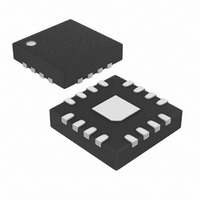MAX5483ETE+T Maxim Integrated Products, MAX5483ETE+T Datasheet - Page 17

MAX5483ETE+T
Manufacturer Part Number
MAX5483ETE+T
Description
IC POT DGTL 10BIT NV 16-TQFN
Manufacturer
Maxim Integrated Products
Datasheet
1.MAX5481EUD.pdf
(20 pages)
Specifications of MAX5483ETE+T
Taps
1024
Resistance (ohms)
10K
Number Of Circuits
1
Temperature Coefficient
35 ppm/°C Typical
Memory Type
Non-Volatile
Interface
SPI, 3-Wire Serial
Voltage - Supply
2.7 V ~ 5.25 V, ±2.5 V ~ 5.25 V
Operating Temperature
-40°C ~ 85°C
Mounting Type
Surface Mount
Package / Case
16-TQFN Exposed Pad
Resistance In Ohms
10K
Lead Free Status / RoHS Status
Lead free / RoHS Compliant
The MAX5481–MAX5484 feature a low-power standby
mode. When the device is not being programmed, it
enters into standby mode and supply current drops to
0.5µA (typ).
The internal EEPROM consists of a nonvolatile register
that retains the last value stored prior to power-down.
The nonvolatile register is programmed to midscale at
the factory. The nonvolatile memory is guaranteed for
50 years of wiper data retention and up to 200,000
wiper write cycles.
Upon power-up, the MAX5481–MAX5484 load the data
stored in the nonvolatile wiper register into the volatile
wiper register, updating the wiper position with the data
stored in the nonvolatile wiper register.
Figure 8. Up/Down Serial-Interface Timing Diagram (SPI/UD = 0)
SCLK(INC)
DIN(U/D)
NOTES:
V
SCLK(INC) MUST BE AT LOGIC HIGH WHEN DIN(U/D) CHANGES STATE.
CS
V
W
W
IS NOT A DIGITAL SIGNAL. IT REPRESENTS A WIPER TRANSITION.
t
CI
______________________________________________________________________________________
10-Bit, Nonvolatile, Linear-Taper Digital
t
S
t
IL
t
Nonvolatile Memory
CYC
t
ID
t
IH
Standby Mode
t
DI
Power-Up
t
IC
The MAX5481–MAX5484 are ideal for circuits requiring
digitally controlled adjustable resistance, such as LCD
contrast control (where voltage biasing adjusts the dis-
play contrast), or programmable filters with adjustable
gain and/or cutoff frequency.
Figures 9 and 10 show an application where a voltage-
divider or a variable resistor is used to make an
adjustable, positive LCD-bias voltage. The op amp pro-
vides buffering and gain to the voltage-divider network
made by the programmable voltage-divider (Figure 9) or
to a fixed resistor and a variable resistor (see Figure 10).
Figure 11 shows an application where a voltage-divider
and a variable resistor are used to make a programma-
ble gain and offset adjustment.
Programmable Gain and Offset Adjustment
WIPER POSITION
STORED
t
CPH
Applications Information
t
Potentiometers
WSC
Positive LCD Bias Control
WIPER POSITION
NOT STORED
t
IK
17











